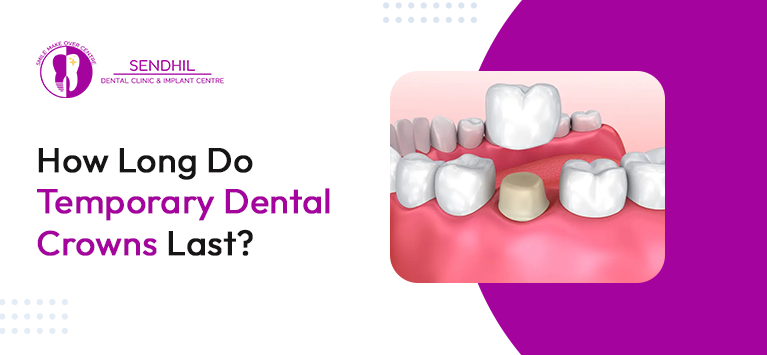A common component of dental procedures is the use of temporary dental crowns. In the meanwhile, a temporary crown serves as a stand-in until the permanent crown is created. To guarantee that teeth are well-maintained during this period of transition, a dental crown’s lifespan is crucial.
What Are Temporary Dental Crowns?
After a repair is completed, the teeth are covered with temporary dental crowns to keep them safe until the permanent crown is placed. In the interim while the final crown is being manufactured, which can occasionally take one to three weeks, these crowns are used to preserve the integrity of the teeth, allow chewing, and allow speaking.
How long does a temporary crown last
A temporary dental crown typically lasts for two to three weeks while a dental lab creates the permanent crown that will be attached to your teeth throughout that period. However, a variety of circumstances can affect how long your crown stays in place in real life.
- Material: Because temporary crowns are not intended to persist, they are frequently comprised of softer materials like acrylic or composite resin.
- Placement: The longevity of the crown can be influenced by the dentist’s ability to place it appropriately.
- Patient Habits: A crown tooth will have a shorter lifespan if the patient grinds their teeth, consumes hard or sticky candies, or neglects to maintain proper oral hygiene.
Factors Influencing the Longevity of Temporary Crowns
Material Quality
Temporary crowns are often composed of composite or acrylic resin. These materials are less durable than the porcelain or metal used in permanent crowns, even if they are dependable in the near term. Acrylic works well for temporary crowns because it is lightweight and readily handled. But because it is not as strong as metal or porcelain, the crown will eventually wear out or chip more easily.
Adhesive Strength
When compared to permanent crowns, the glue used for temporary crowns is weaker. When the permanent crown is finished, it will be simpler to remove them because of this. It also implies that crowns that are placed temporarily are more likely to come off without much force. Stronger adhesives might be more difficult to remove, even when they give better retention.
In order for a temporary crown to endure, proper dental care is essential. Bacteria and plaque can weaken the adhesive holding the crown in place and cause it to come loose or deteriorate below. The temporary crown has to be frequently cleaned with an antiseptic mouthwash, brushed, and flossed in order to maintain its strength.
What you eat has a big impact on how long a temporary dental crown lasts. Steer clear of chewy, hard, or sticky items like gum, sweets, and nuts since they might shatter or come away from the crown. Chew on the side of your mouth that is opposite the temporary restoration to reduce stress on the crown.
Bruxism (Teeth Grinding)
A dental crown’s lifespan can be significantly shortened by bruxism, or teeth grinding. The crown may become worn down or even crack as a result of the constant strain and friction. It is crucial that you inform your dentist if you grind your teeth. They could advise using a night guard to prevent bruxism from harming the crown.
Signs of a Failing Temporary Crown
It’s critical to recognise these symptoms of a failing temporary crown in order to receive timely dental care:
- Sensitivity to temperature: Abnormally high or low body temperature indicates insufficient sealing around the crown.
- Pain or discomfort: Prolonged pain or discomfort is a sign of an ill-fitting crown.
- Looseness: Re-cementing a loose or shaky crown may be necessary.
- Visible Damage: Any visible damage, such as chips or cracks, requires crown replacement.
Tips for Maintaining Temporary Dental Crown Lifespan
Practice Good Oral Hygiene:
By brushing your teeth twice a day and flossing often, you may maintain proper oral hygiene. Concentrate on keeping the area surrounding the temporary crown clean to avoid plaque build-up. Use mouthwash with antibacterial properties to reduce the risk of illness. Dental crown longevity will increase with the completion of this process.
Avoid Problematic Foods:
Avoid foods that are chewy, sticky, or firm, such gum, popcorn, caramel, and nuts. This can harm or separate the temporary crown.
Choose Soft Foods:
You can choose soft meals like spaghetti, mashed potatoes, and yoghurt. They will prolong the life of a crown tooth and are kinder to the temporary crown.
Be Gentle:
To stop it, refrain from eating on the side of your mouth where the temporary crown is placed. Use a mouth guard to shield the crown if you grind your teeth at sleep.
Handle with Care
In the event that your temporary crown loosens, handle it carefully. Do not attempt to fix it yourself since you risk breaking your tooth or injuring it.
Steps to Follow:
- Take off the crown gently to avoid swallowing it.
- Use a toothbrush to clean the exposed tooth region and the crown.
- Use temporary dental cement or dental wax to cover the tooth until you can seek expert assistance.
- To have the crown re-cemented, get in touch with your dentist right away.
Conclusion
In order to protect prepared teeth before the permanent crown is constructed, temporary dental crowns are necessary. Though their lifespan varies depending on factors such as dental cleanliness, eating habits, bond strength, material quality, and tooth grinding, they often endure a few weeks.
You may prolong the life of a dental crown by practising proper oral hygiene, avoiding specific foods, and handling the crown with care. To get the crown re-cemented if it becomes loose, get dental care right away. In order to maintain dental health and enable a smooth transition to the permanent crown, it is imperative that you take proper care of your temporary crown.
To know more, visit — https://www.sendhildental.com/how-long-do-temporary-dental-crowns-last/

